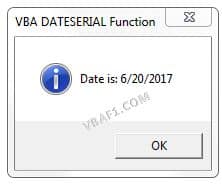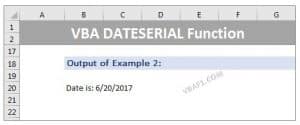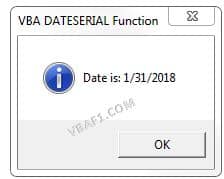VBA DATESERIAL Function in Excel is a built-in function in MS Excel. It returns a date value from a supplied year, month and day. VBA DATESERIAL Function has three input arguments or parameters. In these three arguments all parameters are mandatory. It is a ‘Data and Time’ type function. The VBA DATESERIAL Function can be used in either procedure or function in a VBA editor window in Excel. We can use this function any number of times in any number of procedures or functions. In the following section we learn what is the syntax and parameters of the DATESERIAL Function, where we can use this DATESERIAL Function and its real-time examples.
- Objective
- Syntax of VBA DATESERIAL Function
- Parameters or Arguments of DATESERIAL Function
- Where we can apply or use the VBA DATESERIAL Function?
- Example 1: Create Date using DATESERIAL function and display on the screen
- Example 2: Create Date using DATESERIAL function and display on the Worksheet
- Example 3: Create Date using DATESERIAL function and display on the screen
- Download File
- Instructions to Run VBA Macro Code
- Other Useful Resources
Syntax of the VBA DATESERIAL Function
The syntax of the VBA DATESERIAL Function is
DateSerial(year, month, day)
In the above syntax all 3 arguments are mandatory. We have to specify year, month and day .
Parameters or Arguments
Where
Year: This argument consists of an integer value from 1 through 9999. It represents the year. If we specify any negative value, then negative value subtracts from the current year.
month: It consists of an integer value from 1 through 12. It represents the month. It accepts other values as well, not only between 1 to 12. Sometimes depending on input, the year parameter will change. Here are some use cases for the same.
- If month value is 13, it represents January of the following year.
- If month value is 1, it represents January of the calculated year.
- If month value is 0, it represents December of the previous year.
- If month value is -1, it represents November of the previous year.
day: This parameter consists of an integer value from 1 through 31. It represents the day and accepts other values as well, not only between 1 to 31. Sometimes depending on input, the month and year parameters will change. Here are some use cases for the same.
- If day value is 32 and month is May, it represents January of the calculated year.
- If day value is 1, it represents January of the calculated year.
- If day value is 0, it represents December of the previous year.
- If day value is -1, it represents November of the previous year
Where we can apply or use the VBA DATESERIAL Function?
We can use this VBA DATESERIAL function in MS Office 365, MS Excel 2016, MS Excel 2013, 2011, Excel 2010, Excel 2007, Excel 2003, Excel 2016 for Mac, Excel 2011 for Mac, Excel Online, Excel for iPhone, Excel for iPad, Excel for Android tablets and Excel for Android Mobiles.
Example 1: Create Date using DATESERIAL function and display on the screen
Here is a simple example of the VBA DATESERIAL Function. In this example we are using 3 parameters year, month and date. Finally, we are creating date from those three parameters. Here is the sample example of DATESERIAL function.
Sub VBA_DATESERIAL_Function_Example1()
'Returns a date from the given input Year, Month and Day and Display on the screen
'Variable declaration
Dim iYear As Integer
Dim iMonth As Integer
Dim iDay As Integer
Dim dDate As Date
'Assign Year, Month and Day to multiple variables
iYear = 2017
iMonth = 6
iDay = 20
'Usage of DATESERIAL function in VBA
dDate = DateSerial(iYear, iMonth, iDay)
'Display output on the screen
MsgBox "Date is: " & dDate, vbInformation, "VBA DATESERIAL Function"
End Sub
In the above example ‘iYear’, ‘iMonth’ and iDay’ are declared as an integer data type.
Output: Here is the screen shot of first example output.

Example 2: Create Date using DATESERIAL function and display on the Worksheet
Here is another example of the VBA DATESERIAL Function. This below example macro uses the DATESERIAL Function and returns date on the Worksheet named ‘VBAF1.Com’ in Range ‘B20’.
Sub VBA_DATESERIAL_Function_Example2()
'Returns a date from the given input Year, Month and Day and Dislay on the Worksheet
'Variable declaration
Dim iYear As Integer
Dim iMonth As Integer
Dim iDay As Integer
Dim dDate As Date
'Assign Year, Month and Day to multiple variables
iYear = 2017
iMonth = 6
iDay = 20
'Usage of DATESERIAL function in VBA
dDate = DateSerial(iYear, iMonth, iDay)
'Display output on the worksheet
Sheets("VBAF1.COM").Range("B20") = "Date is: " & dDate
End Sub
Output: Here is the screen shot of second example output.

Example 3: Create Date using DATESERIAL function and display on the screen
Here is one more example with VBA DATESERIAL Function. Finally, it returns date on the screen.
Sub VBA_DATESERIAL_Function_Example3()
'Returns a date from the given input Year, Month and Day and Display on the screen
'Variable declaration
Dim iYear As Integer
Dim iMonth As Integer
Dim iDay As Integer
Dim dDate As Date
'Assign Year, Month and Day to multiple variables
iYear = 2017
iMonth = 13
iDay = 31
'Usage of DATESERIAL function in VBA
dDate = DateSerial(iYear, iMonth, iDay)
'Display output on the screen
MsgBox "Date is: " & dDate, vbInformation, "VBA DATESERIAL Function"
End Sub
In general, we have 12 months in a year. But, in the above specified example we have provided 13 as a month input parameter. So it consider next year January month.
Output: Here is the screen shot of third example output.

Download File
Click on following link to download free example excel workbook to learn more about the VBA DATESERIAL Function.
VBA DATESERIAL Function Examples
Instructions to Run VBA Macro Code or Procedure:
You can refer the following link for the step by step instructions.
Instructions to run VBA Macro Code
Other Useful Resources:
Click on the following links of the useful resources. These helps to learn and gain more knowledge.
VBA Tutorial VBA Functions List VBA Arrays in Excel Blog
VBA Editor Keyboard Shortcut Keys List VBA Interview Questions & Answers
